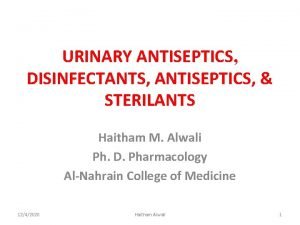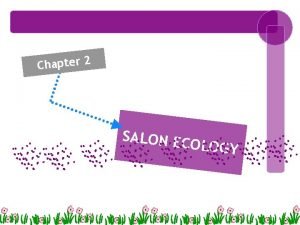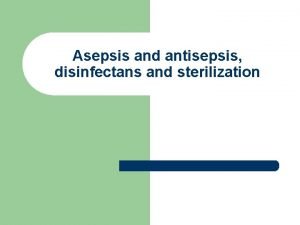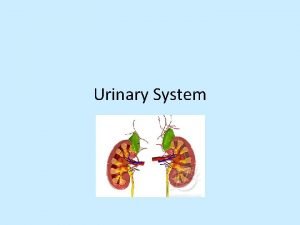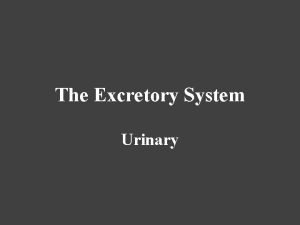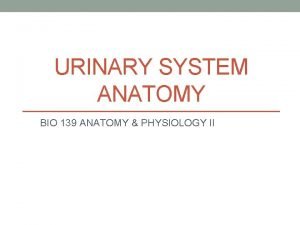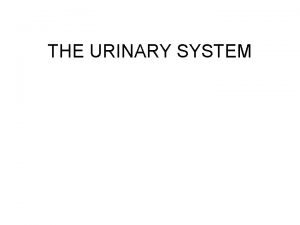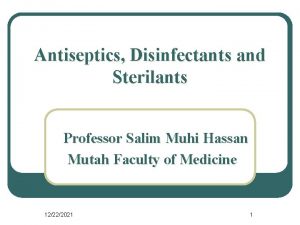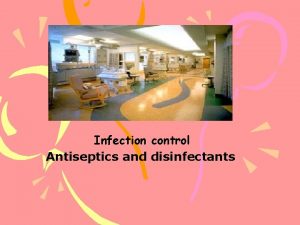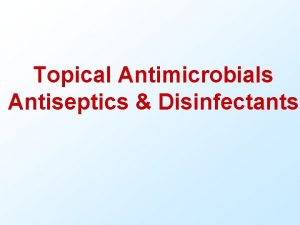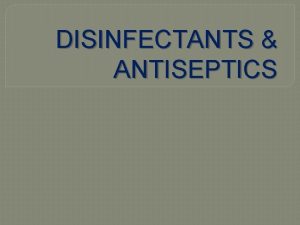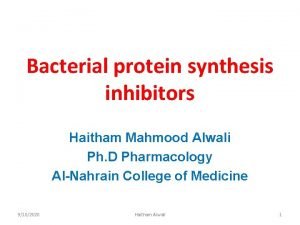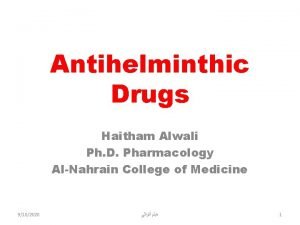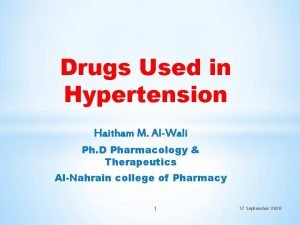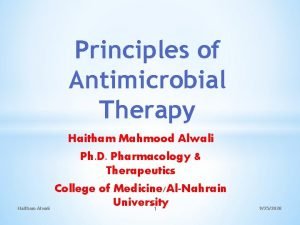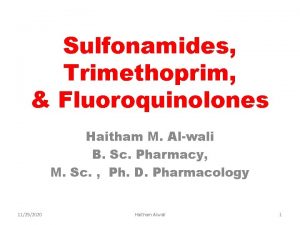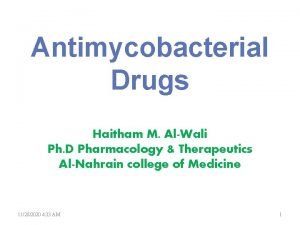URINARY ANTISEPTICS DISINFECTANTS ANTISEPTICS STERILANTS Haitham M Alwali












- Slides: 12

URINARY ANTISEPTICS, DISINFECTANTS, ANTISEPTICS, & STERILANTS Haitham M. Alwali Ph. D. Pharmacology Al-Nahrain College of Medicine 12/4/2020 Haitham Alwali 1

q. Antiseptic An agent used to inhibit bacterial growth in vitro and in vivo q. Disinfectant An agent used to kill microorganisms in an non-living environment q. Sterilization Procedures that kill microorganisms on instruments and dressings; methods include autoclaving, dry heat, and exposure to ethylene oxide. 12/4/2020 Haitham Alwali 2

URINARY ANTISEPTICS Ø UTIs are prevalent in women of child-bearing age and in the elderly population. Ø E. coli is the most common pathogen, causing about 80% of uncomplicated upper and lower UTIs. Staphylococcus saprophyticus is the second most common bacterial pathogen causing UTIs. Ø In addition to cotrimoxazole and the quinolones previously mentioned, UTIs may be treated with any one of a group of agents called urinary tract antiseptics 12/4/2020 Haitham Alwali 3

Ø Urinary antiseptics are oral drugs that are rapidly excreted into the urine and act there to suppress bacteriuria. Ø These drugs lack systemic antibacterial effects but may be toxic. Ø Urinary antiseptics are often administered with acidifying agents because low p. H is an independent inhibitor of bacterial growth in urine. 12/4/2020 Haitham Alwali 4

A. Nitrofurantoin This drug is active against many urinary tract pathogens (but not Proteus or Pseudomonas), and resistance emerges slowly. Ø Single daily doses of the drug can prevent recurrent urinary tract infections, and acidification of the urine enhances its activity. The drug is active orally and is excreted in the urine via filtration and secretion. Ø Adverse effects : gastrointestinal irritation, skin rashes, , phototoxicity, neuropathies, and hemolysis in patients with glucose-6 -phosphate dehydrogenase (G 6 PD) deficiency. 12/4/2020 Haitham Alwali 5

B. Nalidixic Acid Ø This quinolone drug acts against many gramnegative organisms (but not Proteus or Pseudomonas) by mechanisms that may involve acidification or inhibition of DNA gyrase. Ø The drug is active orally and is excreted in the urine partly unchanged and partly as the inactive glucuronide. Ø Toxic effects : include gastrointestinal irritation, glycosuria, skin rashes, phototoxicity, visual disturbances, and CNS stimulation. Ø Nitrofurantoin may antagonize the action of nalidixic acid. 12/4/2020 Haitham Alwali 6

C. Methenamine Ø Methenamine mandelate and methenamine hippurate combine urine acidification with the release of the antibacterial compound formaldehyde at p. H levels lower than 5. 5. Ø These drugs are not usually active against Proteus because these organisms alkalinize the urine. Ø Insoluble complexes form between formaldehyde and sulfonamides, and the drugs should not be used together. 12/4/2020 Haitham Alwali 7

DISINFECTANTS, ANTISEPTICS, & STERILANTS A. Alcohols, Aldehydes, and Acids Ø Ethanol (70%) and isopropanol (70– 90%) are effective skin antiseptics because they denature microbial proteins. Ø Formaldehyde, which also denatures proteins, is too irritating for topical use but is a disinfectant for instruments. Ø Acetic acid (1%) is used in surgical dressings and has activity against gram-negative bacteria, including Pseudomonas, when used as a urinary irrigant and in the external ear. Ø Salicylic acid is useful in the treatment of dermatophyte infections. 12/4/2020 Haitham Alwali 8

B. Halogens Ø Iodine tincture is an effective antiseptic for intact skin and, although it can cause dermatitis, is commonly used in preparing the skin before taking blood samples. Ø Iodine complexed with povidone (povidoneiodine) is widely used, particularly as a preoperative skin antiseptic. Ø Hypochlorous acid, formed when chlorine dissolves in water, is antimicrobial. This is the basis for the use of chlorine and halazone in water purification. 12/4/2020 Haitham Alwali 9

C. Oxidizing Agents Ø Hydrogen peroxide exerts a short-lived antimicrobial action through the release of molecular oxygen. The agent is used as a mouthwash, for cleansing wounds, and for disinfection of contact lenses. Ø Potassium permanganate is an effective bactericidal agent but has the disadvantage of causing persistent brown stains on skin and clothing. 12/4/2020 Haitham Alwali 10

D. Chlorinated Phenols: Ø Owing to its toxicity, phenol itself is used only as a disinfectant of inanimate objects. Mixtures of phenolic derivatives are used in antiseptics but can cause skin irritation. Ø Chlorhexidine is mainly active against grampositive cocci and is commonly used in hospital scrub routines to cleanse skin sites. Ø All antiseptic soaps may cause allergies or photosensitization. 12/4/2020 Haitham Alwali 11

F. Ectoparasiticides Ø Lindane (hexachlorocyclohexane) is used to treat infestations with mites or lice and is also an agricultural insecticide. The agent can be absorbed through the skin; if excessive amounts are applied, toxic effects, including blood dyscrasias and convulsions. Ø Crotamiton is a scabicide with some antipruritic effects, which can be used as an alternative to lindane. Ø Permethrin is used topically in pediculosis and scabies; adverse effects include transient burning, stinging, and pruritus. 12/4/2020 Haitham Alwali 12
 Classification of urinary antiseptics
Classification of urinary antiseptics Haitham hassanieh
Haitham hassanieh Chemical germicides formulated for use on skin
Chemical germicides formulated for use on skin Virucidals are disinfectants used to kill:
Virucidals are disinfectants used to kill: Difference between asepsis and antisepsis
Difference between asepsis and antisepsis After which activity must food handlers wash their hands?
After which activity must food handlers wash their hands? Father of antiseptic
Father of antiseptic When should hand antiseptics be used?
When should hand antiseptics be used? Antidiuretic hormone function
Antidiuretic hormone function Anatomical structure of urinary system
Anatomical structure of urinary system Urinary system model
Urinary system model Pye medical term
Pye medical term Normal constituents of urine
Normal constituents of urine
